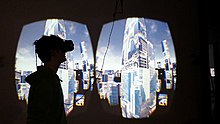Telepresence

Telepresence describes the state of feeling present in a distant environment. The higher the degree of immersion , the more the user feels in the distant environment.
Technical implementation
In order to achieve the feeling of presence in the remote environment, the user is usually represented in the target environment by a teleoperator. This replicates the user's head movements and transmits camera images from the teleoperator's point of view to the user. These images are then shown to the user on a head-mounted display . So he only perceives the distant environment and is put into it. Other telepresent senses, such as hearing, are of course also possible.
In order to give the user the opportunity to manipulate the target environment, he is also often connected to a robot arm via a haptic input device .
The term telepresence is already used by several providers of digital communication systems in a modified meaning under the term " telepresence " when video conference telephony in high resolution and a representation of people in almost life size gives the participants the impression that they are facing each other sit. In the language that has been customary up to now, however, telepresence is differentiated from video telephony through motion sensors and robotics.
Extensive telepresence
In order to enable extensive movement and not just head movements in the distant environment, mobile devices, e.g. B. wheel-based robots are used. Most of the time, the user sits in the teleoperation and controls the long-range movement of the robot via input devices such as joysticks .
However, if the user controls the long-range movement of the robot by his own movement, i.e. walking around, one speaks of long-range telepresence . The advantage here is that the depth sensitivity of the movement is consistent with the visual perception , which on the one hand reduces the risk of simulator disease and on the other hand allows the natural navigation ability of humans to be used.
A major problem here, however, is that the remote environment is usually significantly larger than the actual environment of the user. For this reason, devices such as a two-dimensional treadmill were developed that allow the user to cover infinitely long distances in a limited space. Motion compression represents a purely algorithmic solution to this problem . The user is guided without noticing it on a path that is curved in relation to the visually perceived path. The distance covered and rotations on the spot remain unchanged.
Differentiation from telerobotics
In contrast to telerobotics , the main focus of telepresence is on conveying an impression of presence, so the user should feel that he is on site. The aim is to offer the user a completely transparent and thus also intuitive interface to the remote environment. That is why the methods of telepresence are often used in conjunction with virtual reality .
Web links
- Oliver Grau: Telepresenz - On genealogy and epistemology of interaction and simulation (PDF file; 732 kB)
- Telepresence with the NASA Robonaut2 and Robonaut1
- SFB 453: Realistic Telepresence and Teleaction
- Locomotion Interfaces: two-dimensional treadmill and other devices
- Demonstration videos on extensive telepresence with motion compression at the University of Karlsruhe (TH)
Individual evidence
- ↑ 10,000 moving cities - same but different, Interactive Internet- and telepresence-based installation, 2015 . Marc Lee. Retrieved March 12, 2017.